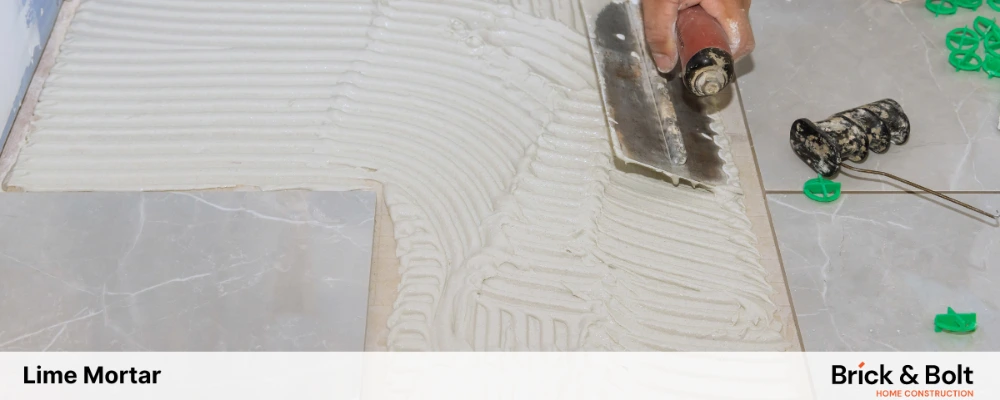Traditional building techniques have become increasingly popular in recent years. Likewise, lime mortar is the talk of the town now. Lime mortar is a durable material made from a mixtures of lime, water, and sand. Since ancient times, this has been a tool to bind bricks, stones, and other masonry materials. It is primarily used to achieve the highest quality of bond in the absence of large cracks.
Though we are familiar with modern materials, this kind of item is perfectly suitable for modern buildings with an increased lifespan. In this article, you will learn the key components, types, significance, and properties of lime mortar.
What is Lime Mortar?
Lime mortar is a mixture of lime, aggregates, and other natural additives. This is a primary choice used in everything from the renovation of existing buildings to the recreation of new ones. This is one of the oldest types of mortar, used in ancient Greece and Rome. Based on their formulation, they are categorised into different types.
Generally, modern cements are less permeable and harder when compared to lime mortars. Its effectiveness and durability have not been well understood, and unfortunately, it’s often used only in historic building restoration.
In addition to its other features, breathability and flexibility are widely discussed.
Key Components of Lime Mortar
Lime mortar is consists of three fundamental ingredients, including lime, sand, and water. The basic ratio is 1 part lime, 3 parts sand, and water usage as per the desired consistency, but it can vary based on project requirements. However, they are explained in detail below:
Lime: acts as a binding agent extracted from limestone, which is categorised into three different types. They include: hydrated lime, quicklime, and hydraulic lime. It directly reacts with carbon dioxide (CO2) and water in the air and provides elements with a strong and durable bond.
Sand: The type and quality of sand greatly influence the mortar’s properties. Choosing the right sand type provides improved strength and workability to the mortar, preventing shrinkage.
Water: The amount of water decides the consistency. It should be adjusted according to the determined binding requirement. It helps hydrate the lime and allows achieving a workable paste.
Properties and Benefits of Lime Mortar
Lime mortar possesses an ideal set of properties, making it a preferred choice for historic building restoration and modern building construction.
Flexibility: Lime mortar is extremely flexible, capable of accommodating the natural movement of buildings. Flexibility is a result of good permeability due to its large interconnected pore structure.
Breathability: Lime mortar provides sufficient breathability, allowing water content to evaporate freely. It efficiently prevents common issues in buildings such as dampness, salt damage, and mould formation.
Durability: When the consistency and quality of the ingredients in the mortar are ideal, exceptional durability can be achieved.
Slow Setting: Unlike cement mortar, lime mortar sets very slowly, providing opportunities for adjustments and corrections during application.
Feasibility: Due to its excellent workability and plasticity, lime mortar is the best choice to shape the masonry work.
Carbonation: Lime mortar easily reacts with carbon dioxide to form calcium carbonate, which is essential to obtain extreme durability and strength.
Resistant to Weather: Lime mortar has extreme tolerance against rain, UV rays, and humidity. Hence, it is one of the highly recommended materials to apply outdoors.
Less Shrinkage and Cracking: In contrast to other types of mortars, lime mortar supports less cracking and shrinkage. Providing an added layer to the buildings typically prevents cracking and lengthens their lifespan.
Applications of Lime Mortar
Lime mortar can be found in a variety of construction projects, particularly in historic buildings.
Ancient Constructions: Lime mortar is a bonding agent ideal for constructing bonding bricks, stones, and other masonry units. It is suitable for both interior and exterior walls, providing durable finishing and protective coatings.
Modern Applications: Similar to historical constructions, lime mortar is gaining popularity in modern buildings. It creates a healthy indoor environment and is primarily used in sustainable building projects.
Historic Building Restoration: Due to its compatibility with natural materials, it is indispensable for restoring historic artefacts and buildings.
Conclusion
Lime mortar is a good option today due to its extreme strength and durability. Generally, Lime mortar is costly then cement mortar. Whether it is a traditional or modern structure, lime mortar can withstand all kinds of issues like cracking, shrinkage, or any harsh environmental conditions. These better properties allow lime mortar to be an all-rounder in both historic and modern constructions compared to cement mortar.
FAQs
Lime mortar is composed of three major ingredients: lime, sand, and water. The lime extracted from limestone acts as the binding agent, sand provides structure, and water activates the mixture with its chemical composition through carbonation.
Yes, lime mortar can be a preferred choice for creating new buildings. It includes outstanding durability, strength, and eco-friendliness, promoting a healthier indoor environment.
Yes, it is available to purchase. When compared to regular mixing, it is quite expensive. Commercially available pre-mixed lime mortar may contain additives that could affect its properties and cause serious damages.
Lime mortar is extremely flexible and breathable compared to cement mortar. It allows moisture to escape and reduces the chances of cracking. Cement mortar sets quickly, but it is still less permeable and contributes to moisture problems in the structures.
Yes, it can be used, but having a basic understanding about correct mixing, application procedures, and masonry techniques helps. They have been applied to building a cob oven and repairing old stone walls.

